Brancaster Chronicle No. 41: Anthony Smart Sculptures
The Sidney Series No.4, 2015-16, mild steel, H93cm. [view 1]
13th August 2016, the artist’s studio near King’s Lynn.
Taking part: Anne Smart, Anthony Smart, John Pollard, Richard Ward, Alexandra Harley, David Lendrum, Helga Joergens-Lendrum, Robin Greenwood, Sarah Greenwood, Charley Greenwood, Hilde Skilton, Mark Skilton, Noela James, Mark James.
https://vimeo.com/180794514http://
The Sidney Series No.4, 2015-16, mild steel, H93cm. [view 2]
The Sidney Series No.5, 2015-16, mild steel, H102.5cm. [view 1]
The Sidney Series No.5, 2015-16, mild steel, H102.5cm. [view 2]
The Sidney Series No.6, 2015-16, mild steel, H94cm. [view 1]
The Sidney Series No.6, 2015-16, mild steel, H94cm. [view 2]
The Sidney Series No.7, 2015-16, mild steel, H99cm. [view 1]
The Sidney Series No.7, 2015-16, mild steel, H99cm. [view 2]
The Sidney Series No.8, 2015-16, mild steel, H85cm. [view 1]
The Sidney Series No.8, 2015-16, mild steel, H85cm. [view 2]
The Sidney Series No.9, 2015-16, mild steel, H103cm. [view 1]
The Sidney Series No.9, 2015-16, mild steel, H103cm. [view 2]
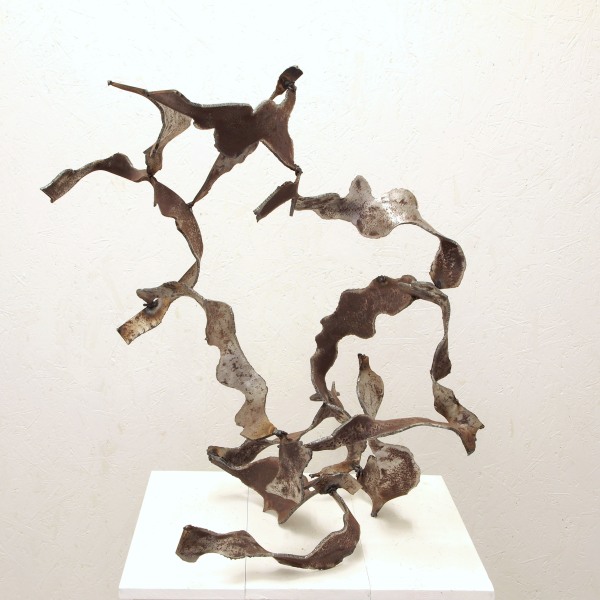
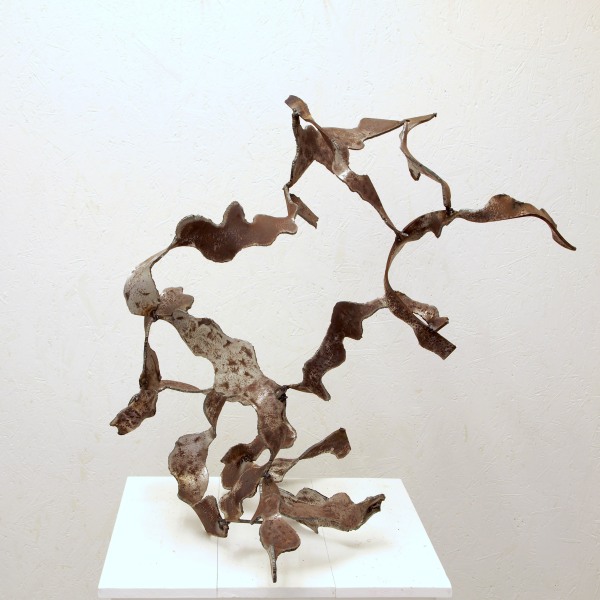

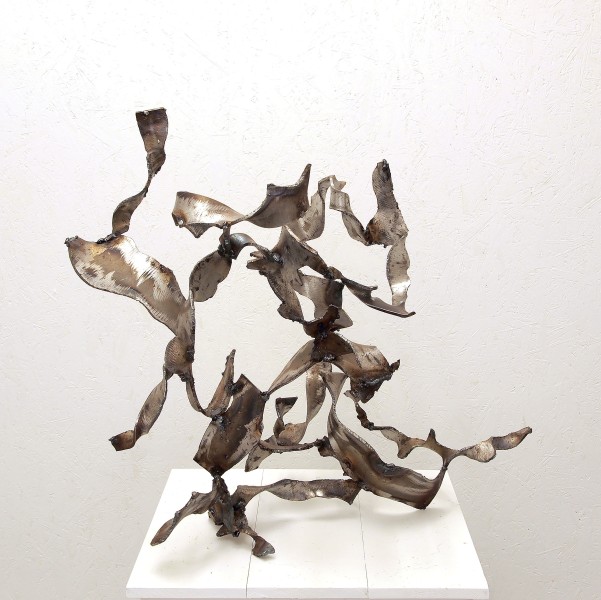


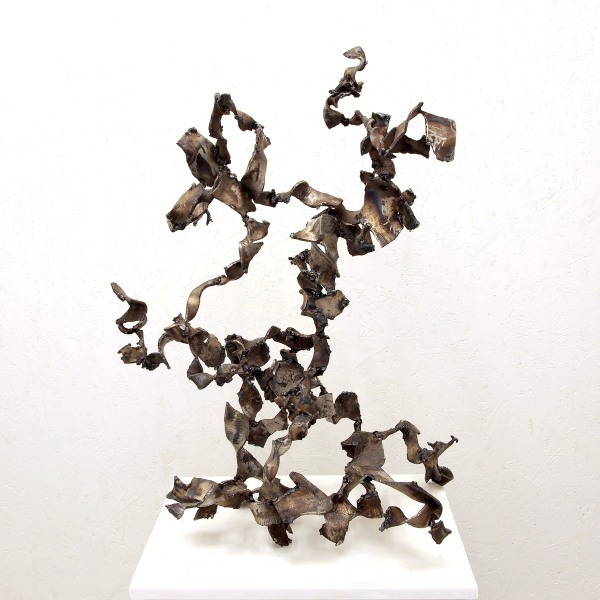
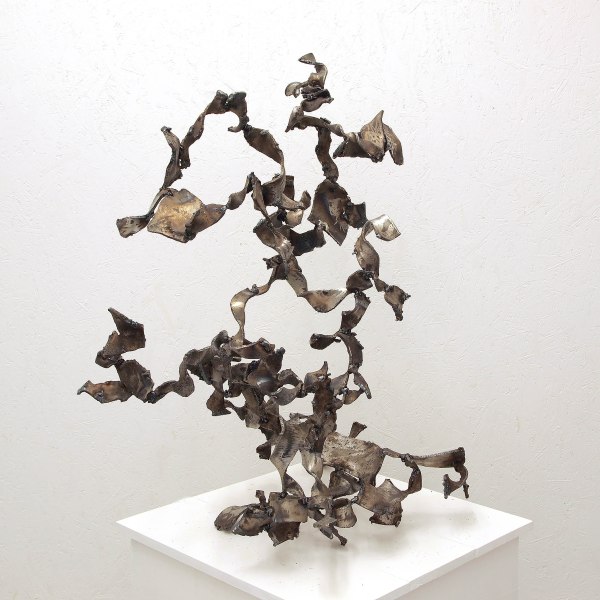



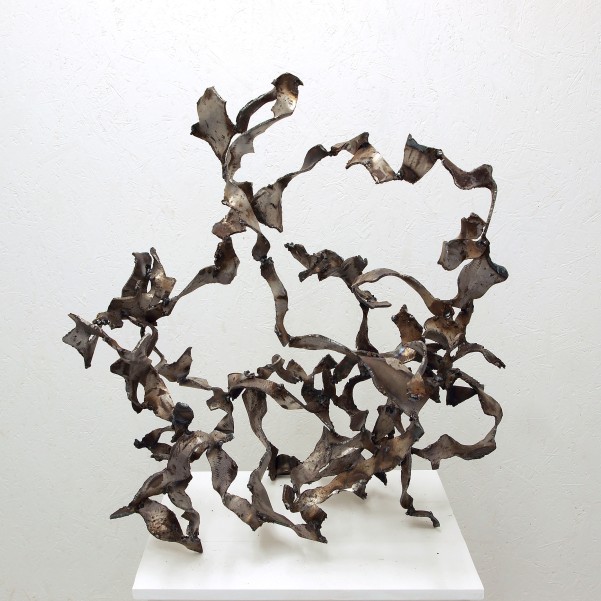
I would want it to be that you could enter these sculptures any where you choose.
I see the steel work as a spatial continuum. That same spatial continuum engages with the floor in a variety of ways as it engages with the space in and around it, again in a variety of ways.Within the business of making the sculpture things are continuously played with and within as it and the material inter relate So turning the piece about 360 degrees in all directions is part of the looking and feeling for the meaning of the structure.
LikeLike
no not at all…that is one of the challenges of making sculpture.
Separating out movement as would be the case with a literal object that does move would break the link between those other qualities one might also wish for in ones sculpture which in combination could constitute “form”….and perhaps meaning.
LikeLiked by 1 person
The piece of steel to which you refer is the second largest in the sculpture and is a curved element with distortions across the curve and sits on the ground on one of its corners.Above that ground contact an element crosses its space and whilst twisting itself bears down on the other corner above that corner sitting on the floor.At a similar height to that and across the curve two pieces of steel pull against the element as it rises up into the space above the floor. Why am I saying all of this? Because it shows how hard it is to describe something three dimensional in a few words and also how hard it is to photograph such a phenomenon.The part of the film which includes this sculpture may clarify where and how the piece is sculpturally. It is an interesting question and simply points to the kind of world three dimensional sculpture lives in as compared to that kind of sculpture that went before it which was flat and could be read as a drawing.You did not really have to see it !……
LikeLike
Is “bamboozled” the word you’re looking for—is it not “flabbergasted,” or “flummoxed,” or “gob-smacked”? Tony’s not a con artist. Not a very good one anyway. I can see right through him!
It is easy to wonder whether or not the two photos of #5 are actually of the same sculpture, but what might be called spatial ambiguity has been part of sculpture—sculpture, painting and drawing—for a long time. Did it start with cubism? With John Pollard’s buddy Tintoretto? Or with cave paintings? Tony’s really into it. But all sculpture engages with it. Put a head by Jacques Lipchitz—not a guy Tony has much time for I bet—out in a yard: it’s going to look one way in the morning, different in the afternoon as the sun’s going down.
You’re put on edge by the photographs. Does the talk help? I can imagine many people listening think the Brancaster gang is just nuts. I can imagine the gang itself has lots of doubts about what it’s doing. The talk helps me though—tremendously—even though (maybe because) I don’t see things the way they do. Maybe tomorrow you’ll be excited instead of put on edge.
Keep asking questions—ask people, but ask the art mostly.
I think there’s a lot of “straightforward” good drawing in Tony’s sculpture, much like the drawing/the swordsmanship in de Kooning’s late paintings. There’s some nice writing about late de Kooning (and spatial ambiguity) here: http://abstractcritical.com/article/willem-de-kooning-at-gagosian-gallery-new-york/
LikeLike
I really enjoyed looking at Tony’s latest work. I think the puzzlement is interesting. He is right that these sculptures change considerably from different views. This seems, perhaps, a necessary thing for a sculpture to work well three dimensionally. But very difficult to pull off. I like the way Tony’s latest sculptures break up the space in between the steel into really interesting areas, you can see this in some of the photos here. The relational aspect of steel to space seems more engaging than before. The space works more in-itself as well, although of course it can only become the space it is with the steel structure.
As for drawing you can make fantastic marks on a canvas, and separate bits of steel, but if they don’t relate to each other meaningfully you just have a group of interesting marks. You can get seduced by areas in isolation, something that the Brancaster ‘gang’ (not a gang Jock, a group of individuals) often comment on, in terms of good ‘bits’. Good bits are easy. Going beyond good bits is really hard!
LikeLiked by 1 person
It was certainly clear to me that you weren’t suggesting Tony’s really a con artist, that you were describing your own disorientation (you’re a nice guy, an intelligent guy, etc.), but your use of the word “bamboozle” allowed me to make the suggestion.
Maybe it’s a suggestion worth pushing a little. In his introduction Tony talked about the way he’s been working with steel recently. It’s a little different from the way he’s worked with it in the past. What he said was clear, interesting, useful—but was it the WHOLE STORY? Was he not hiding something? Of course he was. Should he have tried to tell us the whole story? Of course not. But it’s kind of fun to think about the “transparency” of his sculpture in a kind of moral/ethical light.
I think there’s a real moral/ethical/philosophical dimension to Tony’s work. Maybe it’s something the Brancaster group should talk about more. Maybe they should never talk about it. Maybe some members of the group should. Who knows? What’s interesting to me is that YOU, an “outsider,” kind of brought it up—however inadvertently.
I think it’s important to realize that what the Brancaster group is doing is FOR YOU. Not to please you, not to displease you—but they’re NOT doing it simply for themselves, simply to congratulate themselves on what they’re doing. Even toward the end of all the talk when Tony notices something in #8 that surprises and delights him, he’s laughing at himself as he congratulates himself. It’s FOR YOU, for us, the “outsiders.” It’s about communication. Everything’s about communication, as my mother used to say.
It’s not about confusing you—though, as John notes, your confusion is “interesting:” it provokes us: we all start thinking/talking about the good bits and the bad bits.
The other day I was talking about the “spatial ambiguity” in Tony’s “drawing” as a “good bit.” Today I read this in Alan Gouk’s GREAT essay “To The Young Painter of Today:”
“After then, and at times even before then, Picasso is often led astray, forgets “the understanding” in his quixotic delight in paradoxical transformation. Like Karl Marx (pace Frances Wheen) he is addicted to paradox, antithesis, chiasmus (whatever that is?), punning, dis-logic, private jokes, and like Shostakovich, hidden autobiographical messages in code. (Nothing wrong with that, you might say?)
“And he needs to be forever “in the swim,” up-to-date, in the foreground of the forever new, not exactly of fashion, which he transcends and often anticipates and creates, but of modishness (a la Cocteau); whereas Matisse is magnificently anachronistic, adopting with great discomfort “the modern methods of construction.””
What does all that mean? I don’t know. Certainly it’s time for me to stop talking/thinking—maybe both of us should start drawing or painting . . .
LikeLike
I’m sure that the puzzlement is mainly down to trying to figure out the sculptures just from photos. These sculptures are particularly resistant to working out what’s happening from flat images. All a photograph will do is give you an idea about the steelwork, but these works are for me essentially spatial, and photographs don’t really ‘do’ space. But the problem is made far more complex by the nature of how Tony has used the material in this case – all the steel is cut into curving shapes from thin plate which is then bent and distorted into 3-D articulations, so that the curves of the cutting and the curves of the bending are confounded. It’s pretty impossible to tell from photos what is where and what it is doing. Even in real life, the ways of reading the steelwork articulations are manifold (I would resist calling them ambiguous!), to the extent that we can find new readings all the time as we move about.
This complexity of illusion, which is for photographs such a problem, is in real life working to the sculptures advantage. I do in fact think that these are Tony’s most successful works from the past few years of Brancaster. The pieces of steel are so illusionistic that they damp down the physicality of the material in favour of a new and complex kind of spatiality (though others may disagree about this). The ongoing inventiveness of the “quasi-volumes” in the work is something that we have previously not encountered. I’m calling them “quasi-volumes” because they are not discrete or fixed entities of a kind that might be familiar, but are shifting, self-articulating and merging, one to another. In sculpture No. 9 this redefinition happens at all points in a three-dimensional interplay and interpenetration of space, resulting in the sculpture becoming nigh-on one totality.
The sculptures work by being bound together by their own internal, non-literal spatiality. If there is a downside to this success, it is precisely in that lessening of tensions between the illusionism of the work and the literal, materialistic space that we, as observers, occupy. “Tension” is something we have brought up a few times in discussions about sculpture, but usually with reference to physicality and material, rather than spatiality.
LikeLike
Robin, why do you resist the word “ambiguous”?
Of course I’ve only seen the sculptures through the photographs and the film—and through Shaun’s puzzlement. Shaun’s puzzlement has really opened up Tony’s sculpture for me.
I see more Medardo Rosso, less Rodin.
I see/hear the discussion of that corkscrew-like bit in #6 as almost moralistic—even what Tony said was constrained by that word/idea “abstract”—the specialized sense the word has at Brancaster. But Tony’s sculpture, what #6 itself was “saying”/its “philosophy” was freer, clearer.
The current issue of the NY Review of Books arrived last night. Jed Perl has a great piece on a small show of work by Watteau in New York now. Jed’s piece is behind the paywall (subscribe to NYRB, it’s worth it just for Jed’s writing), but here’s a paragraph—it’s SO perfect for Tony’s work
“Watteau was hardly alone in his recoil from visual lucidity. There are many artists who have launched a critique of clarity as they work to complicate painting’s emotional possibilities. To look for layers of feeling or sensibility in an art that is quite literally all on the surface is to almost immediately find oneself in the grip of a paradox. Piero della Francesca, Leonardo, Giorgione, Vermeer, Watteau, Chardin, Corot, Cezanne, Braque, and Giacometti have all, in their various ways, embraced this paradox. Beginning with the most fundamental spatial and narrative ambiguities, these artists mount ambiguity on ambiguity—not nihilistically, but constructively, in an effort to make a painting subtle, sensuous, elusive. It was Braque who said that painting was like reading tea leaves. How do we read tea leaves?”
I’m just reading Tony’s comment now. I wonder what Shaun thinks. NOT saying what Shaun might think or what I think is in any way better/more correct than what Tony or Robin are saying. Just saying there are BIG differences along with “similarities.” I can read most of Tony’s comment as a description of a pencil drawing by Ingres. Tony’s description has a kind of Rodinesque clumsiness about it, but it’s mostly straightforward. At the end there’s a leap to the “head built” thing: that’s “philosophy” in my book.
LikeLike
Just as patriotism is the last refuge of the scoundrel, so ambiguity is the justification for ten million bad abstract paintings and sculptures. And anyone who would describe Cezanne as an artist who “mount[s] ambiguity on ambiguity” is a literal-minded fool who does not comprehend that one of the paradoxes of art happens when the unambiguous and specific values of literal life are inverted in favour of the equally specific, but opposed, unambiguous values of illusion. To such a fool, the manifold nature of the illusions of art can only be seen as ambiguity, since the visual/abstract meaning is not clear to their literal minds. If this hypothetical fool happens to call themselves an abstract artist, its quids in they will be making genuinely ambiguous art, and revelling in it. Tony is no such fool, far from it, and his work is not ambiguous.
LikeLike
I’ve (kind of) spent the past 40 years as a student at a place that KIND OF teaches just one thing: the meaning of the word “plasticity.” I still don’t understand what the word means, though I understand it a little better than I did 40 years ago.
You’re a young guy (I think). You’re comfortable talking about pixels and voxels. How much time have you spent thinking about the word “plasticity”?
I think the great thing about the Brancaster Chronicles and Abcrit is that there’s lots of talk about “plasticity” at both places. I guess I hear the word “abstract” more than the word “plasticity.” But often enough I think they mean the same thing—and when they don’t, it’s fun to think about the difference. There aren’t many places where you hear this kind of talk these days—at least as far as I know.
So: Is it helpful the think about pixels and voxels? No! The people who want you to talk about pixels are just trying to sell you computers.
I think it might be useful to think about “plasticity” when you listen to/read Tony talking about cutting steel. He’s making lines kind of the same way Ingres did with his pencil—lines that move into depth, lines that create volume, lines that aren’t flat, lines that are “plastic.” Take it easy. Listen to him now. Don’t worry if you don’t understand him. Listen to him again sometime. It’ll make more sense—more and more as time goes by. Plasticity’s real. Tony’s real.
You’re never going to understand Tony’s sculpture fully. Tony doesn’t understand it fully. Robin thinks he does: he’s wrong, as usual. The photos at Brancaster are marvelous. Relax: just eat them up.
You provoked what I had to say about morals and ethics and philosophy. You got me to think about something besides the words “plasticity” or “abstract” in front of Tony’s work. You reminded me of how often Tony has indicated he’s worried about being “honest.” It’s come up when he talks about “hiding” and “transparency” in actual sculpture. It came up in this Brancaster when people started to ask him about waxing his sculpture. Has Tony ever once in his life combed his hair? No. He thinks it’d be phony. Should he? Yes! Should everybody at Brancaster put on make-up before filming a Chronicle? No! I’m being more and more trivial. Thing is: Tony has been asking that question—is this move “honest”?—over and over for years. After years of asking questions, you end up with philosophy in your sculpture—non-trivial philosophy.
Glad you brought up my mother. She would have liked Tony’s sculpture. She would have liked Jed Perl’s appreciation of Watteau. She was no fool.
LikeLike
Robin…stunning…
Regarding paragraph three…
The profile cutting of the flat steel plate creates an illusion. An illusion of movement around and in and out of the shape that the rectangle has now become. It is literal at the same time in that the circumference of the shape is now longer than before yet at the same times an illusion in that the forces of the outline are moving backwards and forwards around the edge of the shape. when the material is twisted [put at its simplest] that that has been described is subjected to literal twisting and at the same time the forces that result are an illusion of forces that are still active within the material and the space around when in fact the literal aspect ended upon the completion of the bend/twist and illusion takes over to exploit the memory of the twisting and bending. How all this activity crosses and moves literally and illusionistically throughout the space is just that tension which holds the space together. Maybe this is the “head built” thing I have referred to and is independent acting in its own world separate of the literalness of our own body space.
LikeLike
I am happy to send you some examples of my work which may illustrate what I mean but not through this thread on Tony’s work. I don’t think we can drain the life out of a painting or sculpture that really works, as it will keep on giving meaning, will,in fact remain very much alive.
The Brancaster’s, in my view, need to be watched with the realisation that they focus on judging finished work and how we continue to struggle with how to put into words what we see, think and feel. We are quite different individuals but I assume we value the struggle, even if in our own ways.
There is loads of important stuff we don’t talk about but that is likely to be more focused on process and the making.
LikeLike
Thank you for your comment…
Regarding your last sentence…. what you suggest could be done is already a part of making these sculptures. Of course whether they are “independently complex” enough would be part of your overall assessment of each individual piece of sculpture. As I have said before complexity can be achieved in the way things are put together as much as in the individual piece of cut material. Transparency i.e.. bringing different views bringing different relationships through the sculpture is also a way of increasing complexity, if you so wish,as is added to all of that walking around the whole sculpture.
p.s. You can of course visit these sculptures …I would look forward to showing you around them.
Cheers. Tony.
LikeLiked by 1 person
For me it is all a step on.
Other people can take the more detached view but I would like to think Robin was right.
Best.
Tony
LikeLike
I do think that the specific pursuit of three-dimensionality which the Brancaster sculptors so forcefully and tenaciously argue for and demonstrate in their work is a genuine departure from the way abstract sculpture has been made previously and that anyone seriously interested in making abstract sculpture has, at the very least, to give it very careful consideration. I don’t however believe that it is helpful to think in terms of one artist’s work superseding that of another unless of course one wants to pursue the perilous objective of a place in the history books. Smith will continue to enjoy a prominent place in the development of abstract sculpture as will Caro but nothing stands still,we take what we can and attempt to move on. I think as abstract sculpture continues to develop it will be interesting to see how sculptors tackle three-dimensionality in materials other than steel.
ps This comment was prompted by exchanges on Alan’s Shchukin piece.
LikeLike